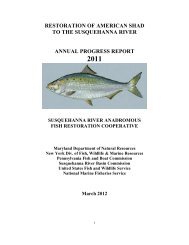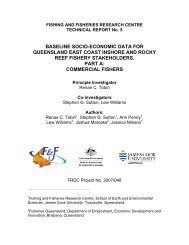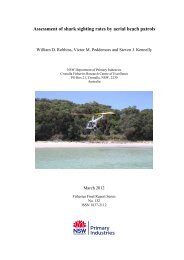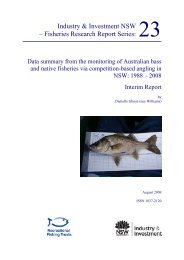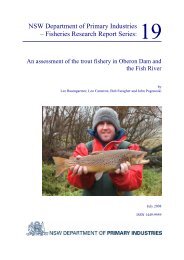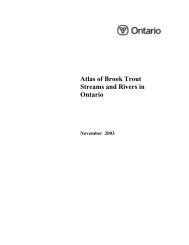NSW Research Report Series No 14 - Fisheries Reports
NSW Research Report Series No 14 - Fisheries Reports
NSW Research Report Series No 14 - Fisheries Reports
You also want an ePaper? Increase the reach of your titles
YUMPU automatically turns print PDFs into web optimized ePapers that Google loves.
Carp in the Upper Murray, Gilligan<br />
4. THE SPREAD OF CARP WITHIN THE UPPER<br />
MURRAY RIVER<br />
Carp are a highly mobile species, capable of migrating up and down rivers throughout the year<br />
(Stuart and Jones 2002). Consequently, it is likely that all areas suitable for colonisation were<br />
invaded shortly after carp first appeared in the upper Murray catchment. Koehn (2004) noted that<br />
carp have ecological tolerances which would allow them to establish populations in any Australian<br />
river system and that the further expansion of carp across most of the remainder of Australia should<br />
be expected. Carp are capable of withstanding water temperatures of 4 – 35 o C, pH of 5 – 10.5,<br />
high turbidity, moderate salinities, high toxicant loads and very low dissolved oxygen levels<br />
(Panek 1987; Mackenzie et al. 2000; Smith 2005). However, carp prefer mid-latitude, low-altitude,<br />
slow flowing or still water, with a silty substrate and access to shallow vegetated areas for<br />
spawning (McCrimmon 1968; Crivelli 1981; Panek 1987; Brown 1998). These types of habitat are<br />
found commonly in off-stream wetlands, billabongs, in large rivers, irrigation canals and large<br />
water storages (such as Lake Hume) in south-eastern Australia (McDowall 1996; Brown 1998;<br />
Stuart and Jones 2002).<br />
Given that Hume Dam prevents colonisation of the upper Murray River by carp from downstream,<br />
their existence in the upper Murray River must have resulted from one or more of the following:<br />
their use as live bait, their deliberate introduction by humans, the transport of their sticky eggs on<br />
waterbirds. When carp were introduced into the neighbouring Murrumbidgee catchment in 1976<br />
(Lintermans 2002), they spread rapidly through the low gradient waterways above Burrinjuck<br />
Dam, but did not reach an elevation of 710 m until 1992 (16 years later). Their present upper<br />
elevation of 760 m was not reached until sometime between 1992 and 2003 (16 to 27 years). Fish<br />
community data collected from 16 sites across the upper Murray catchment in early 2005 indicated<br />
that carp were present at all sites sampled below an altitude of 340 m ASL, but were absent from<br />
all sites at higher altitudes (Arthur Rylah Institute for Environmental <strong>Research</strong>, unpublished data).<br />
Samples collected during this study have increased this altitudinal limit to at least 430 m, with the<br />
added possibility that they exist as far upstream as 450 m ASL (Trevor Davis, pers comm., 2006).<br />
Given their presence up to 760 m elevation in the Murrumbidgee catchment, carp have the ability<br />
to survive at much higher altitudes than they currently exist at in the upper Murray River. We<br />
hypothesise that further colonisation upstream is most probably limited by a natural fish passage<br />
barrier. Apart from colonisation of Khancoban pondage, it is unlikely that carp will continue to<br />
spread beyond their existing distribution in the Murray River. Even if individual carp do manage to<br />
migrate up to, or above, Tom Groggin Station, the shallower depths, faster flow velocities, coarser<br />
riverbed sediments and cooler winter temperatures are likely to inhibit the establishment of a<br />
permanent population. Further, the lack of any suitable spawning and recruitment areas anywhere<br />
in the upper reaches precludes the establishment of an abundant recruiting population. Any carp<br />
observed in the upper Murray River above 450 m altitude are likely to be vagrant individuals<br />
migrating temporarily from further downstream.<br />
<strong>NSW</strong> DPI – <strong>Fisheries</strong> <strong>Research</strong> <strong>Report</strong> <strong>Series</strong>: <strong>No</strong>. <strong>14</strong> 13




